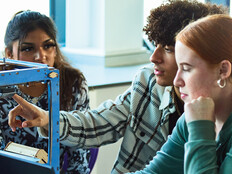Educators and Students Adopt Creative Approach to Hybrid Learning
David Weber, a science teacher and STEM coordinator at Normal West High School in Illinois, explained how the school adapted its associate degree program in computer science to the remote environment, including by offering virtual lessons based on “escape rooms” to freshman students and web-based projects to juniors and seniors.
While remote and hybrid classes have shifted scope and lesson plans, Weber said he has found students have responded by taking creative approaches to their multiyear web projects.
“While there are differences between what we used to do and what we currently do, we have found a way to make those differences just become new opportunities for us,” he said.
Another school that took part in the session, Lanier High School’s Center for Design and Technology in Georgia, has managed to maintain consistent lessons in a hybrid format, using tools such as Google Docs to help improve collaboration. (Thirty to 40 percent of the school’s students are learning in person, with around 60 percent focused on learning virtually.)
One factor that helps is that the center is built around student flexibility. “We let the kids do projects that are authentic to them,” said CDAT founder Michael Reilly.
Margaret Rohrbaugh, a teacher at CDAT, noted that the school district is continuing to attempt laboratory-style experiences even in the hybrid format, with remote students using Zoom to interact with partners studying onsite who offer the physical hands to complete the process.
“We are trying to provide a true laboratory experience, not just for our in-person students, but for those who are learning digitally at home,” she said.
Reilly admitted that a lot of adaptation was taking place, but the district was finding ways to make it work. “At minimum, I can say we’re still trying to look at the pandemic as an opportunity to see unusual situations and unusual opportunities for our kids,” he said.
Zoom Looks for Ways to Be a More Interactive Tool for Students
The challenge for many schools, however, is that the interactive nature of many teaching approaches can be difficult to translate to a virtual environment.
Zoom, the videoconferencing software that has taken over the web over the past year, is one tool that can help bridge this gap.
In a Friday session highlighting new features, company members discussed strategies for expanding the use of breakout rooms and new visual layout approaches, such as the option to present a full Microsoft PowerPoint presentation on a screen while presenting it in “sort of a weather person view,” according to Zoom’s education product lead, Tain Barzso.
One smaller feature that has taken on a more prominent role in recent months thanks to educator input is the hand-raise feature, which allows for more interaction between teachers and students.
Bryan Miller, the senior director of global strategic outreach for the robotics startup Wonder Workshop and a well-known speaker on education issues, noted that the new features come with great possibilities for creative teachers.
“Imagine this: using the breakout rooms as a part of an escape room experience,” Miller explained during the session.
He recommended that administrators take a role as well in helping to build out in-depth experiences using breakout rooms, potentially allowing schools to recreate the experience of switching between classrooms. “The best way for teachers to understand these experiences of what they can do in the classroom is … having the administrator model some of these experiences,” he said.
Zoom is working on a series of other features for the software, including app integration, which it says will allow for more interactive experiences with students down the road. Pat La Morte, the education account executive for Zoom, saw the potential to “really streamline teachers’ workflows by being able to have everything in one spot and become more efficient.”
While some of these features are still in the pipeline or have only just seen release, they show that when it comes to recapturing come of the interactivity of the school experience, the potential is there.
EdTech is covering FETC, so bookmark this page for conference coverage. Follow @EdTech_K12 on Twitter for live updates, and join the conversation using the #FETC hashtag.











